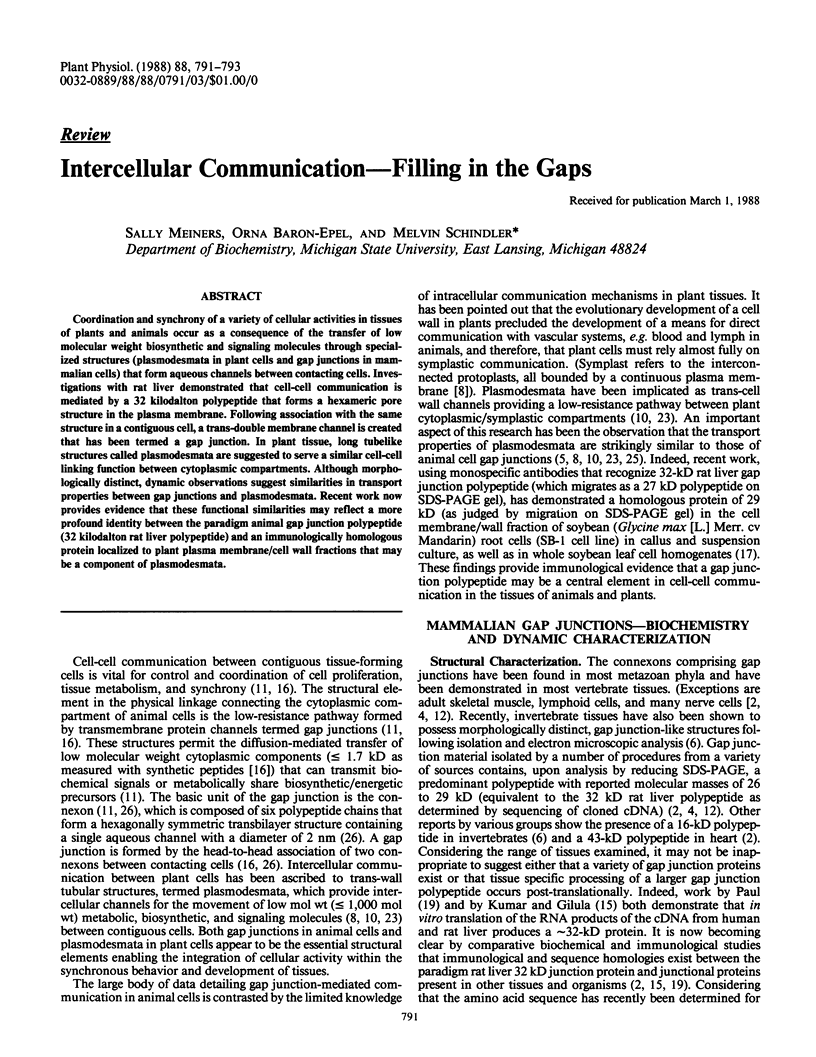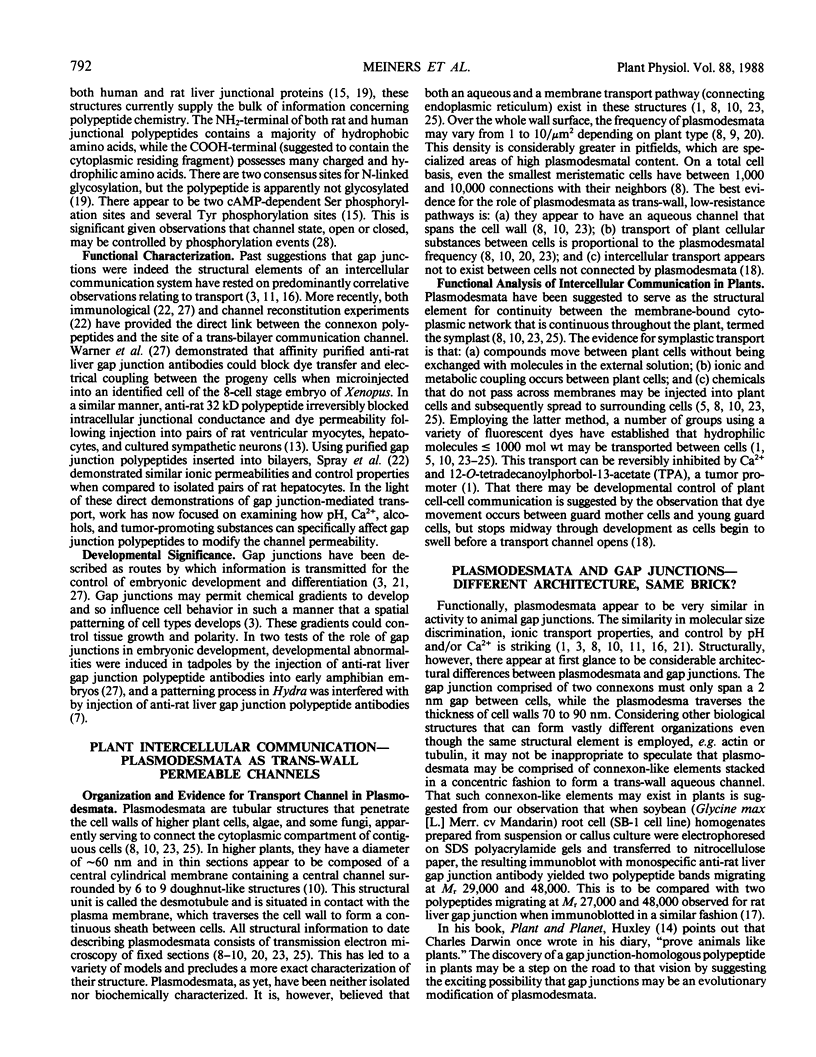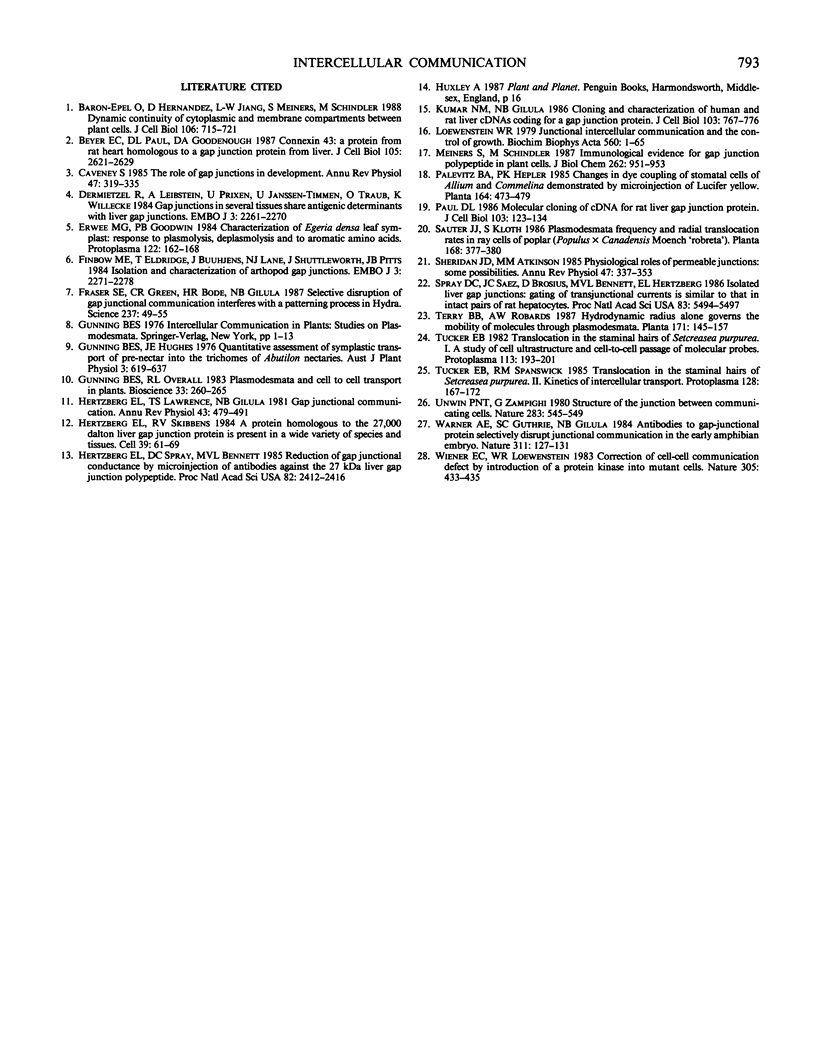Abstract
Coordination and synchrony of a variety of cellular activities in tissues of plants and animals occur as a consequence of the transfer of low molecular weight biosynthetic and signaling molecules through specialized structures (plasmodesmata in plant cells and gap junctions in mammalian cells) that form aqueous channels between contacting cells. Investigations with rat liver demonstrated that cell-cell communication is mediated by a 32 kilodalton polypeptide that forms a hexameric pore structure in the plasma membrane. Following association with the same structure in a contiguous cell, a trans-double membrane channel is created that has been termed a gap junction. In plant tissue, long tubelike structures called plasmodesmata are suggested to serve a similar cell-cell linking function between cytoplasmic compartments. Although morphologically distinct, dynamic observations suggest similarities in transport properties between gap junctions and plasmodesmata. Recent work now provides evidence that these functional similarities may reflect a more profound identity between the paradigm animal gap junction polypeptide (32 kilodalton rat liver polypeptide) and an immunologically homologous protein localized to plant plasma membrane/cell wall fractions that may be a component of plasmodesmata.
Full text
PDF


Selected References
These references are in PubMed. This may not be the complete list of references from this article.
- Baron-Epel O., Hernandez D., Jiang L. W., Meiners S., Schindler M. Dynamic continuity of cytoplasmic and membrane compartments between plant cells. J Cell Biol. 1988 Mar;106(3):715–721. doi: 10.1083/jcb.106.3.715. [DOI] [PMC free article] [PubMed] [Google Scholar]
- Beyer E. C., Paul D. L., Goodenough D. A. Connexin43: a protein from rat heart homologous to a gap junction protein from liver. J Cell Biol. 1987 Dec;105(6 Pt 1):2621–2629. doi: 10.1083/jcb.105.6.2621. [DOI] [PMC free article] [PubMed] [Google Scholar]
- Caveney S. The role of gap junctions in development. Annu Rev Physiol. 1985;47:319–335. doi: 10.1146/annurev.ph.47.030185.001535. [DOI] [PubMed] [Google Scholar]
- Dermietzel R., Leibstein A., Frixen U., Janssen-Timmen U., Traub O., Willecke K. Gap junctions in several tissues share antigenic determinants with liver gap junctions. EMBO J. 1984 Oct;3(10):2261–2270. doi: 10.1002/j.1460-2075.1984.tb02124.x. [DOI] [PMC free article] [PubMed] [Google Scholar]
- Finbow M. E., Buultjens T. E., Lane N. J., Shuttleworth J., Pitts J. D. Isolation and characterisation of arthropod gap junctions. EMBO J. 1984 Oct;3(10):2271–2278. doi: 10.1002/j.1460-2075.1984.tb02125.x. [DOI] [PMC free article] [PubMed] [Google Scholar]
- Fraser S. E., Green C. R., Bode H. R., Gilula N. B. Selective disruption of gap junctional communication interferes with a patterning process in hydra. Science. 1987 Jul 3;237(4810):49–55. doi: 10.1126/science.3037697. [DOI] [PubMed] [Google Scholar]
- Hertzberg E. L., Lawrence T. S., Gilula N. B. Gap junctional communication. Annu Rev Physiol. 1981;43:479–491. doi: 10.1146/annurev.ph.43.030181.002403. [DOI] [PubMed] [Google Scholar]
- Hertzberg E. L., Skibbens R. V. A protein homologous to the 27,000 dalton liver gap junction protein is present in a wide variety of species and tissues. Cell. 1984 Nov;39(1):61–69. doi: 10.1016/0092-8674(84)90191-0. [DOI] [PubMed] [Google Scholar]
- Hertzberg E. L., Spray D. C., Bennett M. V. Reduction of gap junctional conductance by microinjection of antibodies against the 27-kDa liver gap junction polypeptide. Proc Natl Acad Sci U S A. 1985 Apr;82(8):2412–2416. doi: 10.1073/pnas.82.8.2412. [DOI] [PMC free article] [PubMed] [Google Scholar]
- Kumar N. M., Gilula N. B. Cloning and characterization of human and rat liver cDNAs coding for a gap junction protein. J Cell Biol. 1986 Sep;103(3):767–776. doi: 10.1083/jcb.103.3.767. [DOI] [PMC free article] [PubMed] [Google Scholar]
- Loewenstein W. R. Junctional intercellular communication and the control of growth. Biochim Biophys Acta. 1979 Feb 4;560(1):1–65. doi: 10.1016/0304-419x(79)90002-7. [DOI] [PubMed] [Google Scholar]
- Meiners S., Schindler M. Immunological evidence for gap junction polypeptide in plant cells. J Biol Chem. 1987 Jan 25;262(3):951–953. [PubMed] [Google Scholar]
- Paul D. L. Molecular cloning of cDNA for rat liver gap junction protein. J Cell Biol. 1986 Jul;103(1):123–134. doi: 10.1083/jcb.103.1.123. [DOI] [PMC free article] [PubMed] [Google Scholar]
- Sheridan J. D., Atkinson M. M. Physiological roles of permeable junctions: some possibilities. Annu Rev Physiol. 1985;47:337–353. doi: 10.1146/annurev.ph.47.030185.002005. [DOI] [PubMed] [Google Scholar]
- Spray D. C., Saez J. C., Brosius D., Bennett M. V., Hertzberg E. L. Isolated liver gap junctions: gating of transjunctional currents is similar to that in intact pairs of rat hepatocytes. Proc Natl Acad Sci U S A. 1986 Aug;83(15):5494–5497. doi: 10.1073/pnas.83.15.5494. [DOI] [PMC free article] [PubMed] [Google Scholar]
- Unwin P. N., Zampighi G. Structure of the junction between communicating cells. Nature. 1980 Feb 7;283(5747):545–549. doi: 10.1038/283545a0. [DOI] [PubMed] [Google Scholar]
- Warner A. E., Guthrie S. C., Gilula N. B. Antibodies to gap-junctional protein selectively disrupt junctional communication in the early amphibian embryo. Nature. 1984 Sep 13;311(5982):127–131. doi: 10.1038/311127a0. [DOI] [PubMed] [Google Scholar]
- Wiener E. C., Loewenstein W. R. Correction of cell-cell communication defect by introduction of a protein kinase into mutant cells. 1983 Sep 29-Oct 5Nature. 305(5933):433–435. doi: 10.1038/305433a0. [DOI] [PubMed] [Google Scholar]


